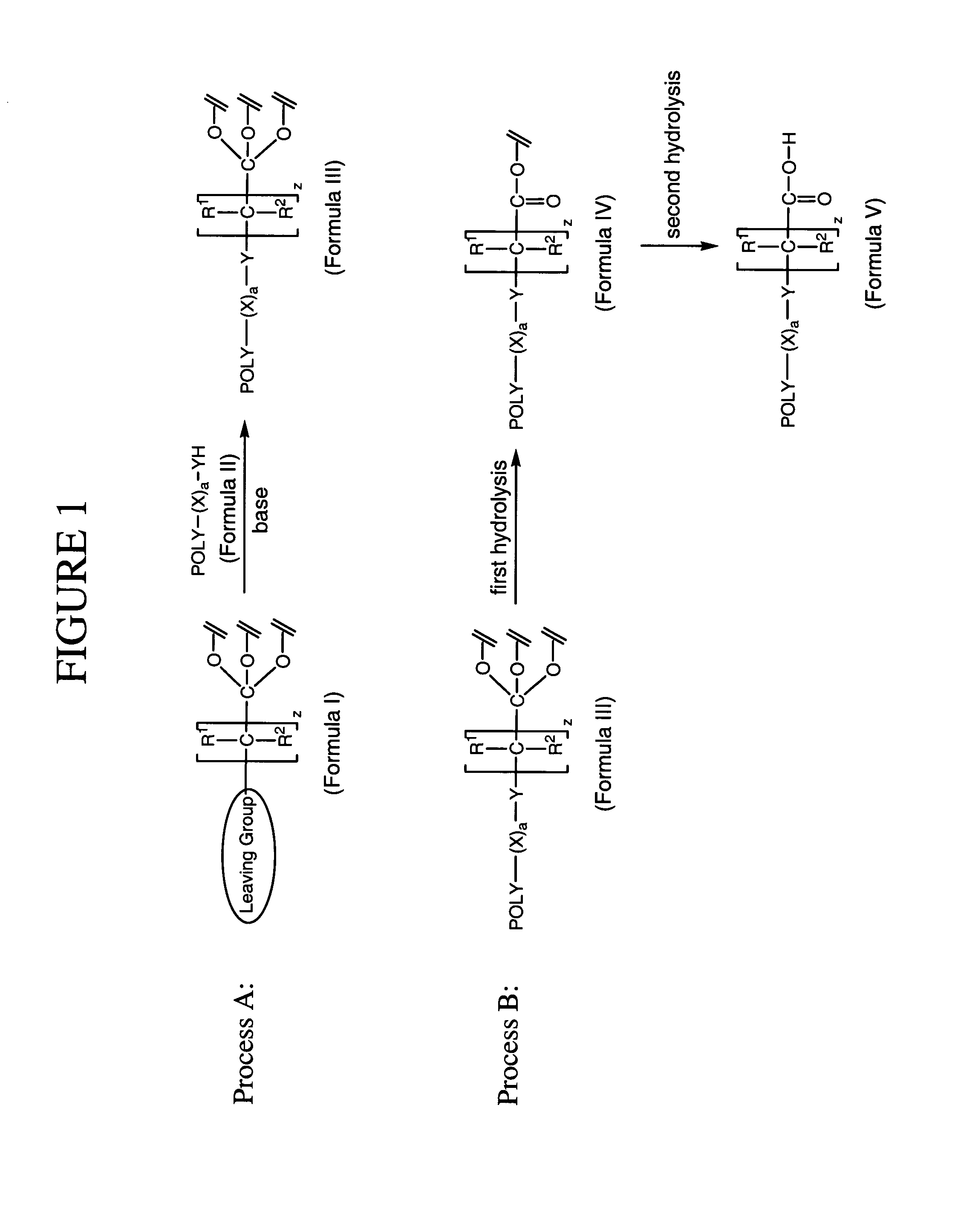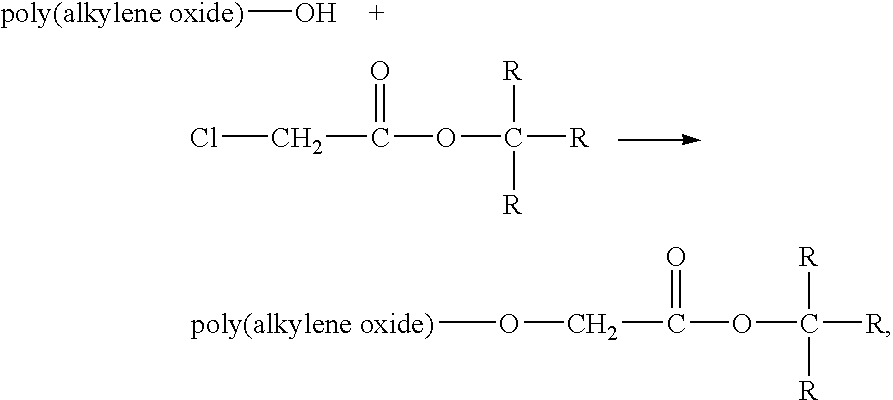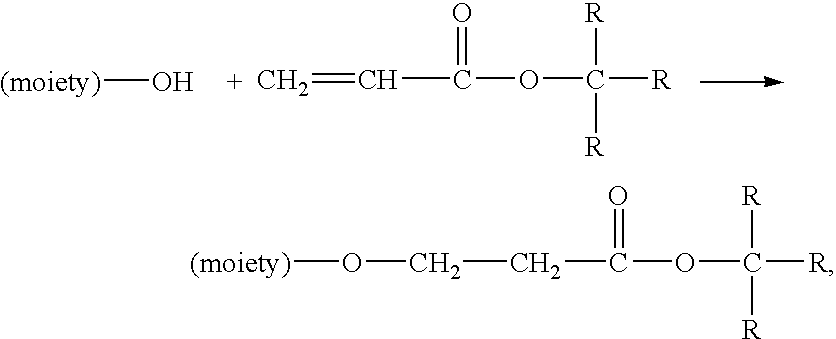Method for preparing water-soluble polymer derivatives bearing a terminal carboxylic acid
a technology of terminal acetic acid and derivatives, applied in the field of new methods for preparing polymer derivatives, can solve the problems of low practical utility of peg method suffers from other drawbacks, and polymer derivatives bearing terminal acetic acid moiety can be difficult to prepar
- Summary
- Abstract
- Description
- Claims
- Application Information
AI Technical Summary
Benefits of technology
Problems solved by technology
Method used
Image
Examples
example 1
Formation of 4-Bromobutyrate ester of 3-methyl-3-hydroxymethyloxetane (MW=251.12)
3-Methyl-3-hydroxymethyloxetane (10.2 g, 0.1 mole) (Sigma-Aldrich Corporation, St. Louis, Mo.) was dissolved in anhydrous dichloromethane (200 ml). Pyridine (9.8 ml, 0.12 moles) was then added to the solution. Thereafter, the solution was cooled to 0° C. and 4-bromobutyryl chloride (18.5 g, 0.1 mole) (Sigma-Aldrich Corporation, St. Louis, Mo.) dissolved in anhydrous dichloromethane (50 ml) was added dropwise over 20 minutes. The mixture was stirred overnight under argon atmosphere. Next, the reaction mixture was washed with water and dried with anhydrous magnesium sulfate. The solvent was then distilled off under reduced pressure. Yield 23.6 g. NMR (d6-DMSO): 1.26 ppm (s, 3H), 2.07 ppm (m, 2H), 2.51 ppm (t, 2H), 3.56 ppm (t, 2H), 4.14 ppm (s, 2H), 4.24 ppm (d, 2H), 4.38 ppm (d, 2H).
example 2
Formation of 1-(3-Bromopropyl)-4-methyl-2,6,7-trioxabicyclo[2,2,2]octane (MW=251.12)
The product of Example 1 (crude 4-bromobutyrate ester of 3-methyl-3-hydroxymethyloxetane, 20.1 g, 0.08 moles) was dissolved in anhydrous dichloromethane (100 ml), the solution was cooled to 0° C. and boron trifluoride diethyl etherate (2.5 ml, 0.022 moles) was added. The mixture was then stirred for four hours at 0° C. Triethylamine (12 ml) was added, the mixture was stirred for 15 minutes, and the solvent was distilled off under reduced pressure. The crude product was dissolved in ethyl ether (180 ml) and the solution was then filtered to remove the solid impurities. Next, ether was distilled off and the product was distilled under reduced pressure (kugelrohr, 110-115° C., 0.05 mm Hg). Yield 15.0 g. NMR (d6-DMSO): 0.74 ppm (s, 3H), 1.68 ppm (m, 2H), 1.88 ppm (m, 2H), 3.52 ppm (t, 2H), 3.81 ppm(s, 6H).
example 3
Synthesis of a PEG-Butanoic Acid Precursor Useful in a Polymerization Reaction
A mixture of anhydrous ethylene glycol (120 g, 1.93 moles), 1.0M solution of potassium tert-butoxide in tert-butanol (70 ml, 0.070 moles), and the product of Example 2 [1-(3-bromopropyl)-4-methyl-2,6,7-trioxabicyclo[2,2,2]octane (15 g, 0.060 moles)] was stirred overnight at 70° C. under an argon atmosphere. After cooling to room temperature, the reaction mixture was added to 600 ml of distilled water. The product was three-times extracted with dichloromethane (150 ml, 125 ml, and 125 ml). The combined extracts were dried with anhydrous magnesium sulfate and the solvent was distilled off under reduced pressure. The product (Compound 1) was then subjected to vacuum distillation (kugelrohr, t=120-130° C., 0.05 mm Hg). Yield 6.2 g. NMR (d6-DMSO): 0.74 ppm (s, 3H), 1.59 ppm (m, 4H), 3.34 ppm (m, 4H), 3.45 ppm (t, 2H), 3.80 ppm(s, 6H), 4.54 ppm (t, 1H).
Schematically, the reaction can be represented as follow...
PUM
| Property | Measurement | Unit |
|---|---|---|
| Mass | aaaaa | aaaaa |
| Mass | aaaaa | aaaaa |
| Mass | aaaaa | aaaaa |
Abstract
Description
Claims
Application Information
 Login to View More
Login to View More - R&D
- Intellectual Property
- Life Sciences
- Materials
- Tech Scout
- Unparalleled Data Quality
- Higher Quality Content
- 60% Fewer Hallucinations
Browse by: Latest US Patents, China's latest patents, Technical Efficacy Thesaurus, Application Domain, Technology Topic, Popular Technical Reports.
© 2025 PatSnap. All rights reserved.Legal|Privacy policy|Modern Slavery Act Transparency Statement|Sitemap|About US| Contact US: help@patsnap.com



